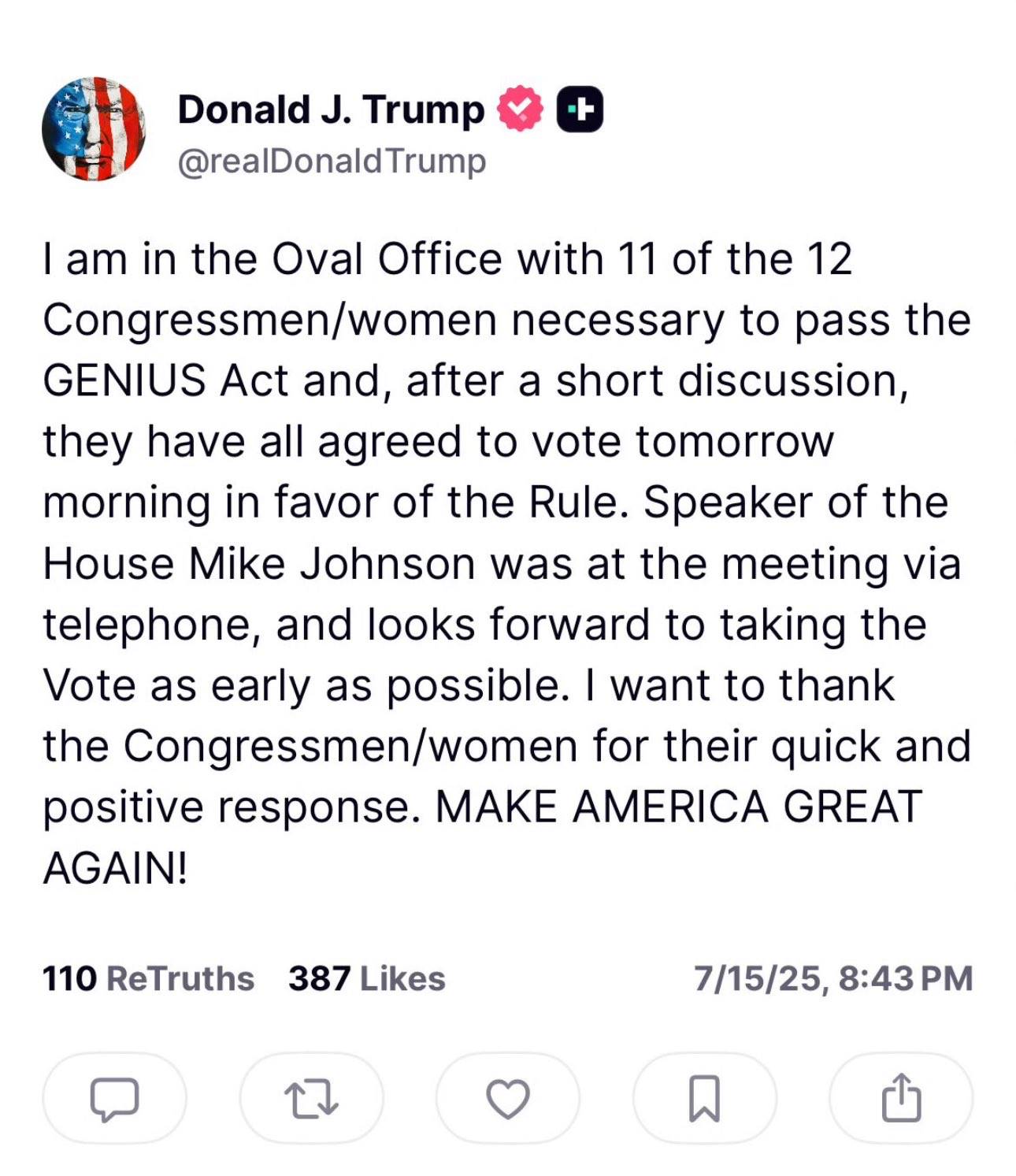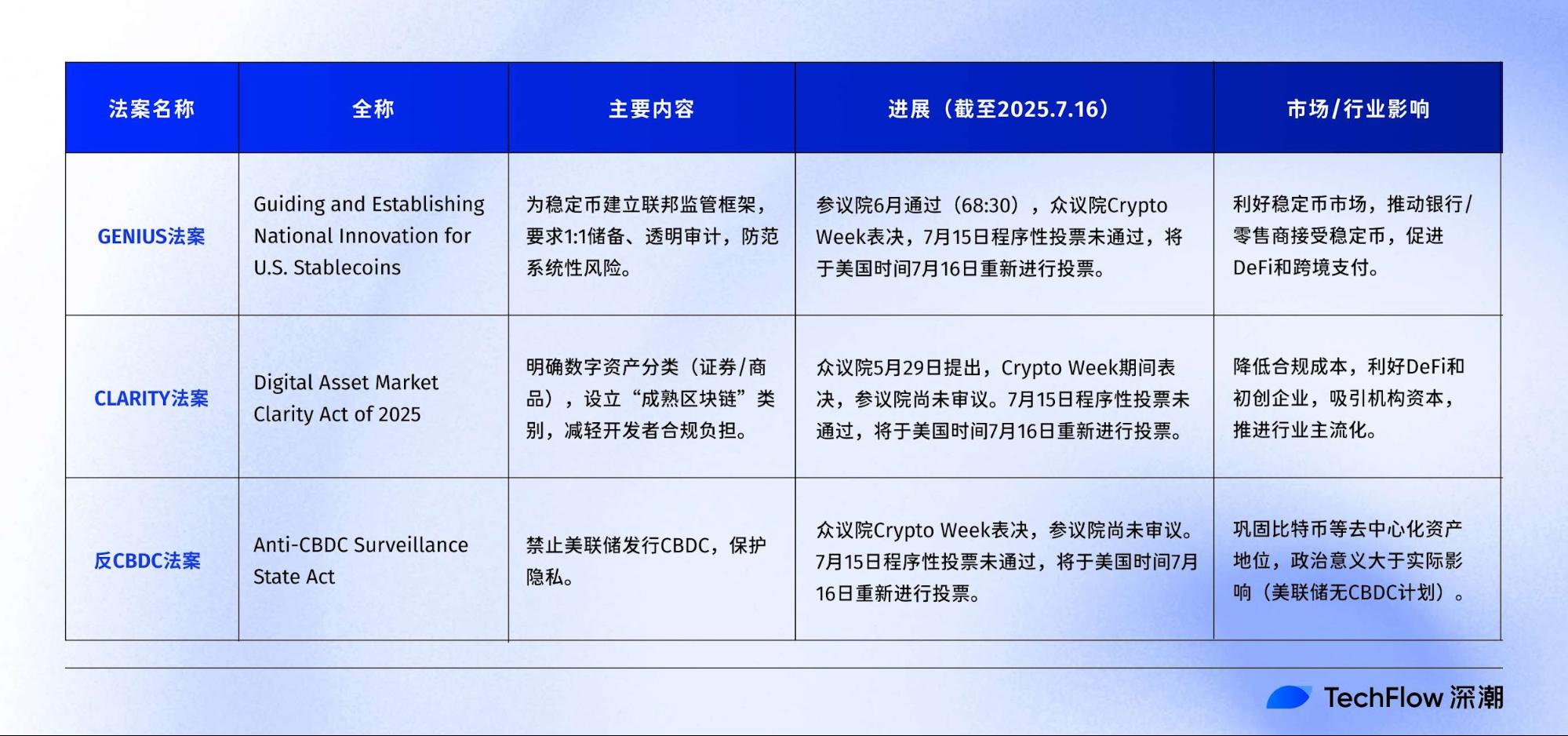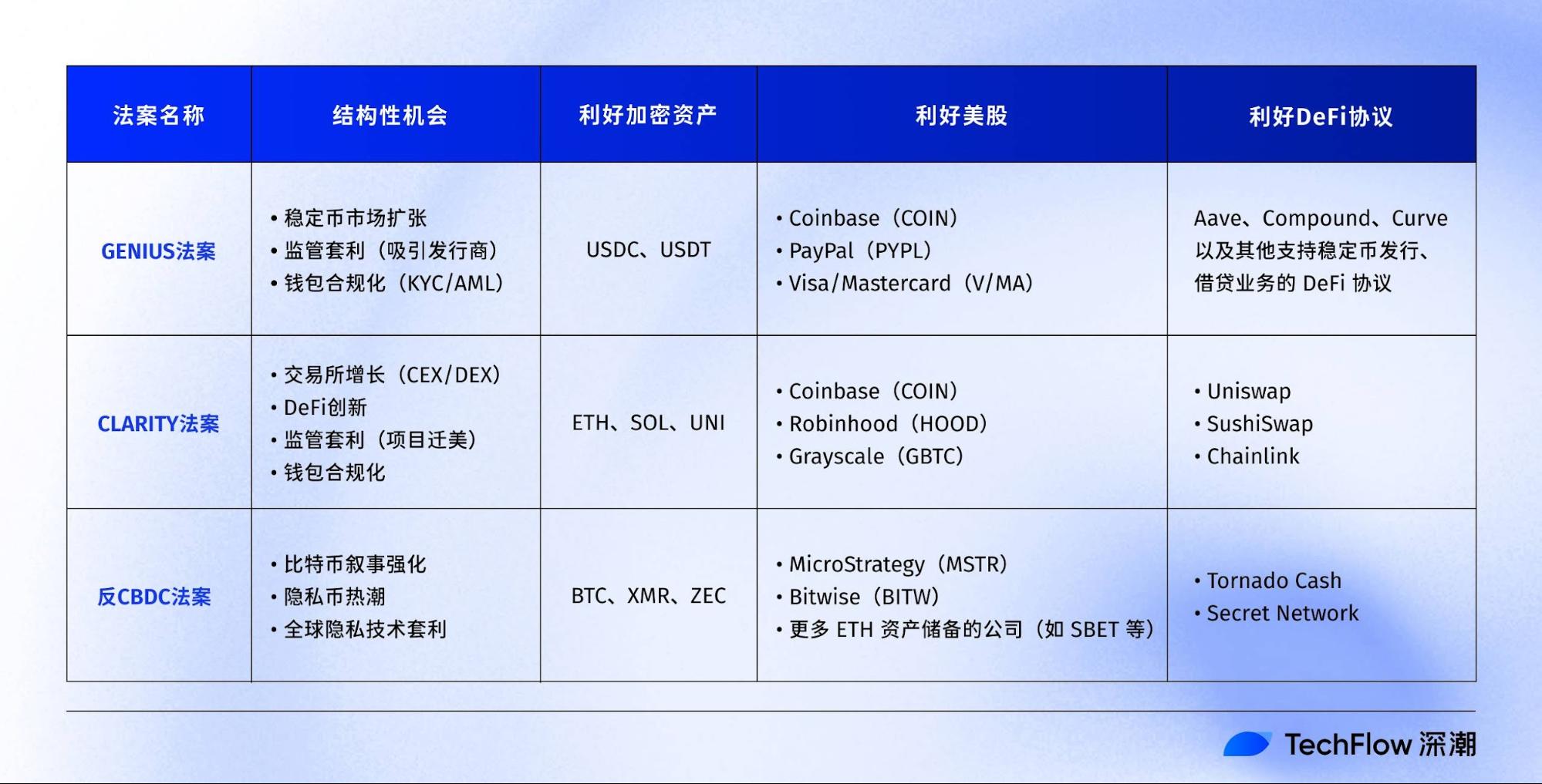Crypto Week has begun. What new opportunities will the three major crypto bills ignite?
In July, the encryption market is set to surge again.
BTC has broken historical highs consecutively, and ETH spot ETFs have maintained a net inflow for 9 consecutive weeks; last week, the net inflow for ETH spot reached 850 million USD, setting a record. The flow of funds has never stopped, and the market is feeling better again.
However, the real catalyst may not be in the price curve, but in the United States House of Representatives in Washington, D.C.
From July 14 to 18, the House announced “Crypto Week,” during which it will focus on three landmark bills: the GENIUS Act, the CLARITY Act, and the anti-CBDC Act, which address stablecoins, digital asset classification, and Central Bank Digital Currency (CBDC), respectively.
This intensive legislative feast is not only a turning point for the American encryption industry but may also influence the direction and asset changes of the entire encryption market.
Let’s take a look at the progress of the three major bills advancing this week and catch the market pulse of Crypto Week.
Bill Overview: Core and Progress of Three Legislative Measures
As of July 16, Crypto Week is in full swing.
The three bills being reviewed by the House of Representatives focus on the core sectors of the encryption market, covering stablecoin payments, decentralized finance (DeFi), and the decentralized narrative of Bitcoin.
The three pieces of legislation each focus on different aspects, but they all point to a common theme—“compliance.”
The “GENIUS” Act: A Legal Cornerstone for Stablecoins
The full name of the GENIUS Act is “Guiding and Establishing National Innovation for U.S. Stablecoins”. It aims to establish a federal regulatory framework for stablecoins, clarifying the qualifications for stablecoin issuers, the 1:1 dollar or U.S. Treasury reserve requirements, and a transparent audit mechanism. Through regulations such as the 1:1 reserve requirement, the Act seeks to ensure that stablecoins are truly “stable”, avoiding a repeat of incidents similar to the 2022 Terra collapse.
In terms of legislative progress, the Senate passed it with a vote of 68 to 30 in June 2025. During this week of Crypto Week, the House of Representatives originally planned to hold a vote on Thursday (July 17, U.S. time), but today, July 15, the House Rules Committee approved the discussion rules, although the procedural vote (to decide whether the bill would enter formal debate) failed with a vote of 196 to 223, with 12 Republican hardliners opposing, preventing the bill from entering debate.
On the evening of July 15, U.S. time, Trump posted on the Truth Social platform that he would meet with 11 opposing Republican members, stating that they had agreed to vote again on the rule provisions on the morning of July 16 (U.S. time). U.S. House Speaker Johnson expressed hope to attempt a procedural vote on the encryption bill again in the House on Wednesday.

Although there have been some unexpected setbacks, the probability of the GENIUS bill passing the vote remains very high. If this vote goes smoothly, it will mean that the GENIUS bill could potentially become the fastest implemented bill during Crypto Week, paving the way for stablecoins to integrate into mainstream finance.
The CLARITY Act: The Innovative Engine of Exchanges and DeFi
The full name of the CLARITY Act is “Digital Asset Market Clarity Act of 2025”, which focuses on the definition and regulatory jurisdiction of digital assets. If passed, it will end the long-standing confusion over the regulation of digital assets by the SEC (Securities and Exchange Commission) and the CFTC (Commodity Futures Trading Commission).
This bill clarifies which encryption assets are classified as securities under SEC regulation or commodities (regulated by CFTC), and establishes a “mature blockchain” category for decentralized networks, exempting certain developers from compliance obligations as fund transmitters.
In terms of legislative progress, this bill was introduced by the House Financial Services Committee and the Agriculture Committee on May 29, 2025, and was scheduled for a vote today. However, due to a procedural voting failure on July 15 (U.S. time), it is stalled along with the GENIUS bill and has not yet entered formal debate.
Trump has currently stated that he has persuaded opposing lawmakers to support its passage, and a vote may take place on July 16 (U.S. time) in the afternoon, with a relatively high probability of approval. If it passes smoothly, it will reduce compliance costs for exchanges like Coinbase and DeFi protocols like Uniswap, unleashing innovative potential.
The “Anti-CBDC” Bill: Decentralization Entrusted to the Market Rather Than the Government
The full name of the Anti-CBDC Act is “Anti-CBDC Surveillance State Act”, which primarily aims to prohibit the Federal Reserve from issuing Central Bank Digital Currency (CBDC) on the grounds that CBDC may lead to excessive government surveillance of personal finances. This act caters to the concerns of crypto market users regarding privacy, strengthens the status of decentralized assets like BTC, and also clears the “competitive” obstacles for the subsequent development of crypto assets.
In terms of legislative progress, although the timeline for the voting and other processes of the anti-CBDC bill has not yet been clarified, the U.S. House Financial Services Committee has explicitly scheduled the anti-CBDC bill for discussion during this week’s Crypto Week. If the U.S. government subsequently releases information regarding its passage, it will greatly enhance confidence in the encryption market and may indirectly promote the development of privacy coins and anonymous technologies.
Legislative Prospects and Market Expectations
The legislative process in the United States requires a bill to be passed by the House of Representatives (a total of 435 votes, needing 218 votes) and the Senate (a total of 100 votes, needing 51 votes). Once the versions are consistent, it is sent to the President for signature.
This week, Crypto Week serves as the voting window for the House of Representatives. Overall, the GENIUS Act is closest to becoming law, while the CLARITY and anti-CBDC bills will take longer.
We can also quickly clarify the progress and details of the three bills using a table:

How Three Legislative Measures are Reshaping the Encryption Landscape
It is clear that the final voting results of Crypto Week will directly affect market sentiment.
The more far-reaching impact is that it not only provides a compliance framework but also drives the industry from “barbaric growth” towards maturity and mainstream acceptance. Let’s take a closer look at the specific impacts of legislation on different encryption tracks.
Stablecoin: Step by step onto the center stage
Stablecoins are undoubtedly one of the “main narratives” in the global financial economy this year. From the 900% stock price increase of stablecoin issuer Circle in the three weeks since its IPO, to JD.com and Ant Group launching Hong Kong dollar stablecoin plans, and today Citigroup’s CEO announcing that Citigroup is exploring the possibility of issuing stablecoins, every step seems to indicate that the stablecoin sector, once scorned by many due to the Terra collapse, is gradually stepping into the spotlight.
The GENIUS Act clarifies the regulatory framework for stablecoins, granting them legitimacy and stability. The $2.38 trillion stablecoin market has become the core of global payments and DeFi. The chain reaction brought about by this action has already begun to manifest, with banks and retail giants (such as Walmart and Amazon) integrating stablecoin payments, accelerating their use in cross-border remittances and payments. Moreover, DeFi protocols that rely on stablecoins for liquidity (such as Aave and Curve) will also be affected, driving up TVL.
Exchanges and DeFi: Catalysts for Innovation and Institutional Capital
The CLARITY Act clears regulatory obstacles for exchanges and DeFi by clarifying the jurisdiction of digital asset regulation, unleashing tremendous potential. Centralized exchanges like Coinbase and decentralized exchanges like Uniswap have long suffered from repeated penalties imposed by the SEC and CFTC due to unclear regulations. After the passage of the Act, the decrease in compliance costs will drive a surge in trading volume, attracting more retail and institutional users to the market.
The opportunities in the Defi sector will be particularly significant: relaxed regulations may encourage developers to launch new protocols, and Web3, NFTs, and decentralized identities (DID) will see significant explosive growth.
The hidden opportunities within this include institutional capital inflows and a surge of startups: financial institutions may accelerate the push for more cryptocurrency ETFs, while developer protection clauses will spur a wave of blockchain startups, attracting venture capital. Compared to the strict regulations of the EU, the lenient policies in the United States will provide investors with ample space for cross-border arbitrage.
Decentralized Assets: Building a Moat for “Privacy”
The anti-CBDC bill defends the concept of decentralization, solidifying BTC’s status as “digital gold” and paving the way for privacy technologies. Bitcoin’s gains are tied to institutional investment and community belief, with the bill further strengthening its anti-censorship narrative, attracting long-term holders. Privacy coins (such as Monero, Zcash, etc.) and anonymous technologies will also rise due to increased demand for privacy protection.
Unlike the CBDC processes in other countries, proponents of anti-CBDC legislation believe that the government’s launch of a CBDC will become a “monitor” of user assets, which directly conflicts with the core decentralized philosophy of Web3. The United States taking the lead in anti-CBDC actions will undoubtedly make people and money in the encryption field more inclined to choose the U.S. as their “base.” If the U.S. becomes a “safe haven” for decentralized assets, it will further consolidate its attractiveness in the global encryption market.
Crypto Week sets the tone for the future of the industry.
Since the “encryption President” Trump took office, the attitude of the U.S. government towards the cryptocurrency sector has undergone a significant shift.
There are also quite a few Wall Street institutions and U.S. listed companies that have sensed the U.S. government’s shift in attitude towards encryption. The government’s push for industry compliance has undoubtedly broken the last concerns of these giants. The amount of funds that a “rule-less” market can accommodate is limited, while a market established with “rules” can allow massive amounts of funds to flow in. This will undoubtedly lead to a huge influx of capital into mainstream encryptions such as BTC and ETH, as well as more encryption tracks.
Under the legislative windfall, structural opportunities for investors.
In such a trend of transformation, from the perspective of cryptocurrency market investors, what other opportunities might there be?
Please note that all the following text is the author’s personal thoughts and experiences and does not represent any investment advice. The encryption market changes dramatically; although legislation has brought benefits, it is still necessary to do your own research.

- GENIUS Act (Stablecoin)
The key aspect of the GENIUS Act lies in injecting compliance dynamics into the stablecoin market, promoting its application in payments and DeFi, with the market size expected to grow rapidly.
The bill, compared to the EU MiCA, offers a more relaxed regulatory environment, which could further attract global stablecoin issuers to register in the United States, creating opportunities for regulatory arbitrage.
Not only Circle and Tether, but when more companies can issue their own stablecoins and operate in compliance in the future, these companies will benefit from the positive narrative of encryption, and their stocks may also perform well.
At the same time, as the use and bearing front end of stablecoins, the opportunities that the wallet sector can gain will far exceed those of the past. By integrating KYC/AML functions, compliant wallets will attract more institutional users and retail investors to enter the market.
In terms of specific assets, encryption assets such as USDC and USDT (growing market share), DeFi protocols like Aave and Compound (lending), Curve (stablecoin exchange); US stocks like Circle (CRCL), Coinbase (COIN, large stablecoin trading volume), PayPal (PYPL, exploring stablecoin payments), Visa/Mastercard (V/MA, payment integration) are all worth further attention.
(Reading Reference:The stablecoin legislation GENIUS Act has been passed. Which encryption assets will benefit from this?)
- CLARITY Act: Potential Growth of Exchanges and DeFi
The LARITY Act reduces compliance costs for exchanges and DeFi projects by clarifying asset classification and developer protections, driving trading volume and a wave of innovation. Centralized exchanges and decentralized exchanges will benefit from user growth.
Beneficial assets include: encryption assets such as ETH (core of DeFi), SOL (high-performance blockchain), UNI (Uniswap); US stocks like Coinbase (COIN), Robinhood (HOOD, supports encryption trading), Grayscale (GBTC, Bitcoin/Ethereum trust); DeFi protocols like Uniswap, SushiSwap, Chainlink (cross-chain).
- Anti-CBDC Bill: Long-term Value of Decentralized Assets
The Anti-CBDC Act prohibits the Federal Reserve from issuing CBDCs, strengthening the appeal of Bitcoin as a decentralized store of value, attracting long-term holders and institutional funds. At the same time, the Act emphasizes privacy protection, which will to some extent create narrative space for privacy coins (such as Monero, Zcash) and the development of anonymous trading technologies.
Positive assets include: encryption assets such as BTC, ETH, XMR, ZEC; US stocks such as MicroStrategy (MSTR), Bitwise (BITW, encryption asset management), and more companies with ETH asset reserves; DeFi protocols like Tornado Cash (anonymous trading) and so on.
(Reading ReferenceETH reserve companies become the new favorites of US stocks, reviewing the businesses and behind-the-scenes drivers of 4 star enterprises.)
Overall, the three major bills are driving three trends: accelerated institutional capital inflow, the integration of encryption and traditional finance, and the rise of Web3 startups.
If there must be a strategy and steps for investment, then short-term focus on stablecoin-related assets and companies, mid-term layout on DeFi blue chips, and long-term holding of BTC, paying attention to privacy coins and new Web3 startups that meet version requirements under the new regulatory environment would be a good choice.
Statement:
- This article is reproduced from [TechFlow] Copyright belongs to the original author [TechFlow] If there are any objections to the reproduction, please contact Gate Learn TeamThe team will process it as quickly as possible according to the relevant procedures.
- Disclaimer: The views and opinions expressed in this article are solely those of the author and do not constitute any investment advice.
- Other language versions of the article are translated by the Gate Learn team, unless otherwise stated.GateUnder such circumstances, it is prohibited to copy, disseminate, or plagiarize translated articles.





